University Of California San Diego
-
- Turbulence Microstructure Measurements from a Wave Powered Profiler Marine Technology, Jul 2013 #42
The Wirewalker (WW) profiling vehicle developed by the Ocean Physics Group at Scripps Institution of Oceanography provides a platform for observing oceanographic phenomena that vary rapidly in depth and time. The smooth, “free rising” mode of operation of the WW makes it a suitable platform for the measurement of small-scale turbulence. A collaborative attempt between SIO and Rockland Scientific Inc. (RSI) to gather estimates of microstructure and the dissipation of turbulent kinetic energy was carried out in the summer of 2012 using a WW and an RSI MicroRider turbulence payload package. The WW platform provided a unique opportunity for RSI to test the performance of the MR over fast and repetitious autonomous profiles in a single location, observing the time evolution of turbulence features in the water column.
The Wirewalker system consists of positively buoyant vehicle that is driven along a wire by surface waves. The wire is used to suspend a 10kg subsurface weight from a surface float (typically 0.5m diameter). The float-wire-subsurface weight assembly moves vertically with surface waves, while a cam mechanism inside the vehicle rectifies that two-way motion into one direction motion (downwards). Once the bottom stop is encountered, the cam mechanism is mechanically disengaged, and the positively buoyant vehicle rises to the surface, completely decoupled from the wire. In this way, high quality oceanographic data can be collected on each upcast.
As the WW is a completely mechanical design, it has proven to be a robust, reliable profiler. Compared to buoyancy-controlled floats and gliders, which have limited payload capacity, the WW only requires rough ballasting and can rapidly accommodate large and complex payloads. Equally capable in drifting and moored modes, WWs have been deployed extensively in the Eastern Pacific, Equatorial, Indian and South Atlantic Oceans, carrying CTDs, oxygen sensors, fluorometers and current meters. For example, an array of three WW units array was deployed for 60 days in 50 m depth off the South African coast where the array collected over 100,000 profiles. This is equivalent to over 6,000 km travelled of profile data. Given a low to moderate sea state, a WW will complete a round trip to 50 m in approximately six minutes, with vertical resolution less than 5 cm, given appropriately fast sampling sensors.
The MicroRider Instrument
The MicroRider (MR) instrument is a modular, self-contained turbulence profiler designed to integrate with a variety of instrument platforms. It has been successfully deployment on AUVs, ocean gliders and profiling floats. The MR carries two velocity shear probes, two fast-response thermistors, a pressure sensor, tilt sensor and acceleration sensors. The data from the sensors are internally recorded within the instrument that are then downloaded through a serial connection.
WireWalker/MicroRider Integration
The MicroRider and Nortek 2 MHz Aquadopp current meter were mounted on one of the WW rails, with the microstructure sensors roughly 20cm above the WW’s leading edge. A Seabird 49 FastCat CTD, Turner Designs Cyclops 7 chlorophyll-a fluorometer, and a data logger were mounted on the opposite rail. A fin was also rail-mounted in order to align the microstructure sensors into the ambient flow. The combination of rail-mounted vane and rail mount location ensured the microstructure sensors were sampling water undisturbed by the WW wake.
The MR draws ~1W of power during operation, which was supplied by the data acquisition system on the WW. MR data were recorded internally; the WW data logger recorded from all other sensors.
Experimental Methodology
The MR-WW integrated system was tested over two deployments in 30 m of water in La Jolla Cove, CA. Each deployment was 3.5 days in duration. Round trip of each profile from the surface to 25 m depth was approximately 3.5 minutes, which provided over 1,500 upcast profiles over each deployment (total: 3,102 profiles over seven days).
Each upcast resulted in less than 5 cm vertical resolution throughout the water column of horizontal and vertical currents, density, chlorophyll distribution, and less than 1 cm vertical resolution in microstructure temperature and turbulence.
Results
The MR-WW system proved effective at measuring temperature microstructure and estimating the dissipation of turbulent kinetic energy. The study area is subject to strong internal wave forcing. With the MR-WW pair, we were able to observe regions of enhanced mixing in the bottom boundary layer, at the base of the thermocline where current shear was at a maximum and in regions undergoing internal wave induced strain (Fig. 3). These data demonstrate the utility of the MR-WW pair to observe the evolution of mixing and turbulent features in a temporally and spatial resolved sense.
As we move forward with MR-WW collaboration, we will use the platform to study the dynamics of mixing in systems where dissipative processes are unsteady in space and time, and the detailed distribution of mixing, the dissipation of turbulent kinetic energy and fluxes of momentum and buoyancy are required.
Acknowledgements
RSI provided the MicroRider instrument and technical support. A WW platform, Sea-bird CTD, Turner Designs Fluorometer, and Nortek current meter and at-sea operations were provided by the SIO Ocean Physics Group.
The Authors
Andrew J. Lucas, Ph.D.
Assistant Research Oceanographer
Marine Physical Laboratory
Scripps Institution of Oceanography
University of California San Diego
Rob Pinkel, Ph.D.
Professor of Oceanography
Marine Physical Laboratory
Scripps Institution of Oceanography
University of California San Diego
Michael Goldin
Principle Engineer
Ocean Physics Group
Scripps Institution of Oceanography
University of California San Diego
Rolf G. Lueck, Ph.D.
President
Rockland Scientific Inc.
Jeremy Hancyk
Director of Business Development
Rockland Scientific Inc.
(As published in the September 2013 edition of Marine Technologies Reporter - www.seadiscovery.com)
-
- Sailing for Science Marine Technology, Jul 2013 #52
,” said Bruce Appelgate, associate director for ship operations and marine technical support with Scripps Institution of Oceanography at the University of California San Diego. “We are able to share these facilities with institutions and scientists all over the U.S. and the world.” “We’re seeing a trend over
-
- Hacking 4 Environment: Oceans - Creating Entrepreneurs from Scientists and Students Marine Technology, Jul 2020 #46
The University of California Santa Cruz (UCSC) and the University of California San Diego (UCSD) recently completed a first-of-its-kind course that had student teams working to develop creative solutions to complex challenges facing our oceans – and the results are a reminder of the value in trying
-
- Blue Tech Economic Engine Shifts into High Gear Marine Technology, Oct 2014 #40
the Navy and Marine Corps. There are major defense and academic research facilities such as the Navy’s Space and Naval Warfare Command (SPAWAR), and the University of California – San Diego’s Scripps Institution of Oceanography. There are many factors that contribute to the success and cohesion of this commercial
-
- From Learning to Earning Marine Technology, Oct 2013 #30
Scripps works to bring new tech to the marketplace Scripps Institution of Oceanography, a division of the University of California, San Diego, has been a leader in academic research for most of its 110-year history. Though for much of that time the research findings and academic knowledge were largely
-
- University Of California Plans To Build Large Oceanographic Vessel Maritime Reporter, May 1977 #24
vessels in the Scripps fleet that have served their useful life. Scripps Institution of Oceanography is the oceanographic division of the University of California, San Diego, and has been in continuous operation for over 72 years. Scripps operates seven research ships and two research platforms
-
- U.S. Navy's AGOR 27: R/V Neil Armstrong Maritime Reporter, May 2014 #40
detail design evolved over many months with frequent reviews by NAVSEA, the Office of Naval Research (ONR), the National Science Foundation (NSF) and the University National Oceanographic Laboratory System (UNOLS). On several occasions, DCI hosted review meetings attended by more than 40 people. Rear Admiral
-
- AGOR 27 Comes to Life as the R/V Neil Armstrong Marine Technology, May 2014 #40
detail design evolved over many months with frequent reviews by NAVSEA, the Office of Naval Research (ONR), the National Science Foundation (NSF) and the University National Oceanographic Laboratory System (UNOLS). On several occasions, DCI hosted review meetings attended by more than 40 people. Rear Admiral
-
- New Ships Join the US Research Fleet Marine Technology, Oct 2015 #14
make a cruise a success.” Amanda Nicole Netburn, a PhD candidate in biological oceanography at Scripps Institution of Oceanography at the University of California San Diego, says many students do not become actively involved in research cruises until it is time to start loading the ship, which it turns out
-
- View from the Top: Greg Murphy Marine Technology, May 2016 #8
development to The Maritime Alliance where he helps organize the largest maritime technology cluster in the United States. He graduated in 2008 from the University of California, San Diego with a degree in political science. (As published in the May 2016 edition of Marine Technology Reporter
-
- Ship Repair: Inside the $60m Refit of RV Roger Revelle Maritime Reporter, Jan 2021 #30
bottom, bow to stern. The ship is owned by the Office of Naval Research and has been operated by Scripps Institution of Oceanography at the University of California San Diego since 1996. It is one of the largest ships in the U.S. Academic Research Fleet, an important asset to U.S. oceanographic research due
-
 )
March 2024 - Marine Technology Reporter page: 39
)
March 2024 - Marine Technology Reporter page: 39into this hugely fascinating ? eld. There are many good published refer- ences available from the library. On-line, a good place to start is Battery University at
. FEEDBACK Readers are encouraged to share their ocean lander experi- ence, projects, inventions, and feedback by writing -
 )
March 2024 - Marine Technology Reporter page: 32
)
March 2024 - Marine Technology Reporter page: 32(SMD) designed, devel- and has attained collection ef? ciency rates of at least 97% in oped and delivered the mining machinery planned for the recent university trials. Solwara 1 Sea? oor Massive Sulphides project some 15 years Ian Maskell, principal engineer, says: “The eyes of the ago, and it is now
-
 )
March 2024 - Marine Technology Reporter page: 23
)
March 2024 - Marine Technology Reporter page: 23in terms of the amount of crustal material produced by volcanoes,” added Jackie Caplan-Auerbach, geology professor at THE UNKNOWN Western Washington University. “This is where new tectonic plates are created, and where hydrothermal vent and mineral deposits form.” IN THE What’s All the Comm-ocean? The
-
 )
March 2024 - Marine Technology Reporter page: 15
)
March 2024 - Marine Technology Reporter page: 15even in remote locations like the Antarctic. Engineering and Mechatronics at Villanova And for users who tend to operate in areas with drastic University and a Master of Engineering changes in water density, strong currents, and storm condi- in Systems Engineering and Project tions – such as the
-
 )
March 2024 - Marine Technology Reporter page: 6
)
March 2024 - Marine Technology Reporter page: 6of Commerce, acting and Deputy Administrator of the ence degree from Shang- National Oceanic and Atmospheric Administration (NOAA), and hai Ocean University in 2018. He proposed making thick wall Oceanographer of the Navy. He has a bachelor’s degree from glass spheres to Nautilus Marine Service/Vitrovex
-
 )
April 2024 - Maritime Reporter and Engineering News page: 28
)
April 2024 - Maritime Reporter and Engineering News page: 28FEATURE INTERVIEW track missiles and warheads for the Mis- sile Defense Agency, and it travels with its support ship, the MV Hercules. For our Service Support ships, we have the two hospital ships, USNS Mer- cy and Comfort; two rescue and salvage ships; two submarine tenders; and the Sixth Fleet ?
-
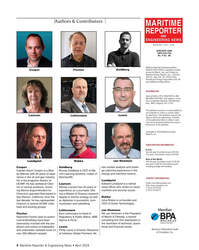 )
April 2024 - Maritime Reporter and Engineering News page: 4
)
April 2024 - Maritime Reporter and Engineering News page: 4Authors & Contributors MARITIME REPORTER AND ENGINEERING NEWS M A R I N E L I N K . C O M ISSN-0025-3448 USPS-016-750 No. 4 Vol. 86 Maritime Reporter/Engineering News (ISSN # 0025-3448) is published monthly Cooper Fischer Goldberg except for March, July, and October by Maritime Activity Reports, Inc.
-
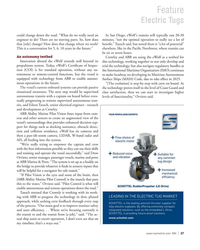 )
April 2024 - Marine News page: 37
)
April 2024 - Marine News page: 37Feature Electric Tugs could change down the road. “What do we really need an In San Diego, eWolf’s transits will typically run 20-30 engineer to do? There are no moving parts. So, how does minutes, “not the optimal operation to really see a lot of that [role] change? How does that change where we work?
-
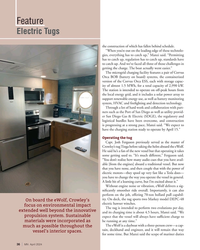 )
April 2024 - Marine News page: 36
)
April 2024 - Marine News page: 36Feature Electric Tugs the construction of which has fallen behind schedule. “When you’re out on the leading edge of these technolo- gies, everything has to catch up,” Manzi said. “Permitting has to catch up, regulation has to catch up, standards have to catch up. And we’ve faced all three of those challenge
-
 )
April 2024 - Marine News page: 35
)
April 2024 - Marine News page: 35Capt. Josh Ferguson, master of the eWolf. Administration (MARAD), which all provided ? nancial support and other resources. “This tug becomes somewhat commercially viable be- cause of the grant process,” Manzi said. “Unlike a ferry service that’s paid for by tax dollars, we have to collect fares and
-
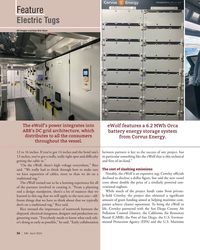 )
April 2024 - Marine News page: 34
)
April 2024 - Marine News page: 34Feature Electric Tugs All images courtesy Eric Haun The eWolf’s power integrates into eWolf features a 6.2 MWh Orca ABB’s DC grid architecture, which battery energy storage system distributes to all the consumers from Corvus Energy. throughout the vessel. 12 to 16 inches. If you’ve got 14 inches and
-
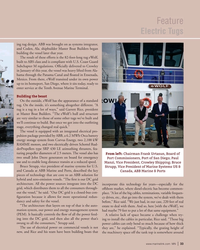 )
April 2024 - Marine News page: 33
)
April 2024 - Marine News page: 33Feature Electric Tugs ing tug design. ABB was brought on as systems integrator, and Coden, Ala. shipbuilder Master Boat Builders began building the vessel later that year. The result of these efforts is the 82-foot-long tug eWolf, built to ABS class and is compliant with U.S. Coast Guard Subchapter M
-
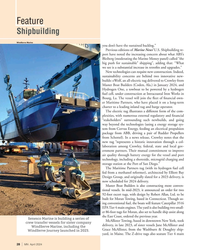 )
April 2024 - Marine News page: 28
)
April 2024 - Marine News page: 28Feature Shipbuilding WindServe Marine you don’t have the sustained backlog.” Previous editions of Marine News’ U.S. Shipbuilding re- port have noted the increasing concern about what ABS’s Bleiberg (moderating the Marine Money panel) called “the big push for sustainable” shipping”, adding that: “What we
-
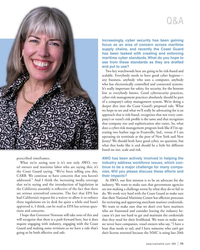 )
April 2024 - Marine News page: 11
)
April 2024 - Marine News page: 11Q&A Increasingly, cyber security has been gaining focus as an area of concern across maritime supply chains, and recently the Coast Guard has been tasked with creating and enforcing maritime cyber standards. What do you hope to see from these standards as they are drafted and put to use? Two key
-
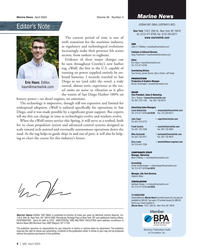 )
April 2024 - Marine News page: 4
)
April 2024 - Marine News page: 4Marine News April 2024 Volume 35 Number 4 Marine News (ISSN#1087-3864) (USPS#013-952) Editor’s Note New York: 118 E. 25th St., New York, NY 10010 tel: (212) 477-6700; fax: (212) 254-6271 www.marinelink.com The current period of time is one of swift transition for the maritime industry, CEO as regulatory
-
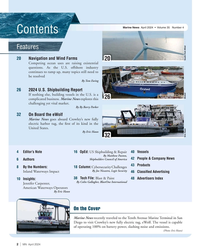 )
April 2024 - Marine News page: 2
)
April 2024 - Marine News page: 2Marine News April 2024 • Volume 35 Number 4 Contents Features 20 Navigation and Wind Farms 20 Competing ocean uses are raising existential questions. As the U.S. offshore industry continues to ramp up, many topics still need to be resolved By Tom Ewing 26 2024 U.S. Shipbuilding Report If
-
 )
February 2024 - Maritime Reporter and Engineering News page: 22
)
February 2024 - Maritime Reporter and Engineering News page: 22Wabtec is huge, pervasive in power across in- the journey to your present position? dustries, but not broadly known globally in the I graduated from the University of Notre Dame with an maritime sector. Please give a ‘By the Numbers’ undergraduate in Mechanical Engineering and started with look at the company
-
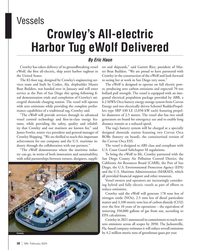 )
February 2024 - Marine News page: 38
)
February 2024 - Marine News page: 38Vessels Crowley’s All-electric Harbor Tug eWolf Delivered By Eric Haun Crowley has taken delivery of its groundbreaking vessel ers and shipyards,” said Garrett Rice, president of Mas- eWolf, the ? rst all-electric, ship assist harbor tugboat in ter Boat Builders. “We are proud to have partnered with the
-
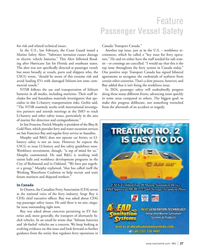 )
February 2024 - Marine News page: 27
)
February 2024 - Marine News page: 27Feature Passenger Vessel Safety ? re risk and related technical issues. Canada: Transport Canada.” In the U.S., last February, the Coast Guard issued a Another top issue, just as in the U.S. – workforce re- Marine Safety Alert: “Saltwater intrusion causes damage cruitment, which he called a “key issue for
-
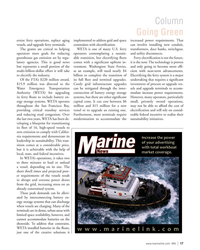 )
February 2024 - Marine News page: 17
)
February 2024 - Marine News page: 17Column Going Green ernize ferry operations, replace aging implemented to address grid and space increased power requirements. That vessels, and upgrade ferry terminals. constraints with electri? cation. can involve installing new conduit, The grants are critical to helping WETA is one of many U.S.
-
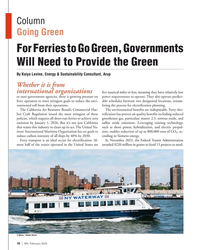 )
February 2024 - Marine News page: 16
)
February 2024 - Marine News page: 16Column Going Green For Ferries to Go Green, Governments Will Need to Provide the Green By Kaiya Levine, Energy & Sustainability Consultant, Arup Whether it is from international organizations ? ve nautical miles or less, meaning they have relatively low or state government agencies, there is growing
-
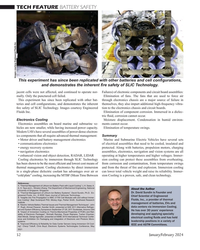 )
January 2024 - Marine Technology Reporter page: 52
)
January 2024 - Marine Technology Reporter page: 52Battery Pack with Liquid Cooling”; L.H. Sawa, A. A. O. Taya and L. Winston Zhang; The Department of Mechanical Engineering, National About the Author University of Singapore, Singapore Dr. David Sundin is Founder and 2. “Thermal Management of Lithium-Ion Battery Systems”, David Sundin, Ph.D. En- gineered
-
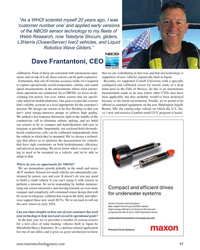 )
January 2024 - Marine Technology Reporter page: 49
)
January 2024 - Marine Technology Reporter page: 49. supportive of new vehicles organically built in Japan. Fortunately, that sort of extreme accuracy really isn’t required Recently, we supported Cornell University with a specially to capture operationally useful temperature, salinity, and sound con? gured and calibrated sensor for remote study of a deep
-
 )
January 2024 - Marine Technology Reporter page: 31
)
January 2024 - Marine Technology Reporter page: 31at depths up to 1,000 feet. serve as a moored training ship (MTS ton. Some of the 688s were pulled from Hammerhead consists of a mooring 701) and the Nuclear Power School service at their mid-life point rather than module that plants itself on the bot- in Charleson, S.C. Likewise USS San incur the
